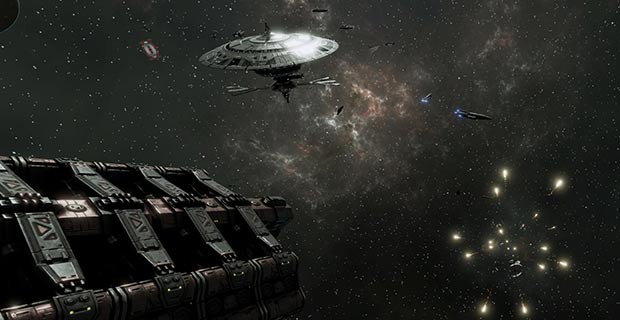

Divert power to whatever subsystem you need most. Posture plays a key role in every battle. You will need to predict opponent’s moves, and match your own strategies accordingly, like an epic game of space chess, without necessarily needing to sacrifice your pawns (though it does happen). The second part of gameplay is in the battles themselves, where determining position and strategy in an open space battlefield will be key to emerging victorious. Battlefields will become littered with debris from exploding ships. Sometimes choosing the “Auto-Resolve” option will give you better results than actually playing the battle, but pay attention to the victory and casualties percentages it shows prior to the fight, since you may not want to risk losing that valuable ship or officer even if you win the match. If one of your secondary fleets is set to engage the enemy, you can choose to “Auto-Resolve” the battle. For main story missions, your Daidalos must be docked at the mission marker location for the campaign to continue, again forcing you to think strategically about where you are moving your fleets. If a location contains your Daidalos shipyard, or a fleet is docked at a secondary mission marker, you must take control in the battle itself. Plan which ships to bring carefully.Īt the end of your turn, any locations that contain opposing forces will battle.

Your fleets jump into battle using Faster-Than-Light travel.

You can also rush promote an officer, but this takes Requisition Points, which are far harder to come by than Tylium. The officers can level up from battle experience, improving how many ships they can command and what improved stat boosts they can take into battle. At the end of each turn, your pieces move, timed secondary missions count down, and Cylons appear at random locations among the colonies.īuilding ships may take multiple turns, though you can rush the build for a larger amount of Tylium, and assigning officers to your fleets will give bonuses to their capabilities in battle. The command station plays like a board game, in that you spend a turn building ships, assigning or promoting officers, and moving your fleets around the board. The first being directly from your command center as you oversee everything from your ship locations in the Cyrannus system, to your officers and ships you can build and what blueprints you have access to. Your actions here determine the fate of the colonies. Losing too many colonies will stall the campaign until you can regain their trust. If you fail to protect a colony too often, they will leave the Quorum, and you will lose access to their tribute. Safe colonies give support with Tylium, and allow you to recruit officers from these colonies. These allow you to build ships, buy blueprints for more powerful ships and weaponry, and recruit officers to bolster your fleet. Some missions require you to guard civilian transports, allowing you to move them to defensible positions.Ĭompleting missions earns you Tylium and Requisition Points, the game’s two currencies. The campaign tells your story during these engagements, which involves core story missions that progress the campaign, timed side quests, and randomly appearing Cylon skirmishes that need to be dealt with so your colonies remain safe.
Battlestar galactica deadlock xbox one review series#
Taking place during the First Cylon War, around 40 years before the Battlestar Galactica series begins, you take on the role of the commander of the shipyard Daidalos, and oversee the Colonial Fleet as you fight off Cylon invasions and protect the Twelve Colonies of Kobol. A defensive posture helps to identify threats. In this Battlestar Galactica Deadlock review, we’ll take a look at how the game works, and whether or not it belongs in your collection, or is best thrown down a trash chute.


 0 kommentar(er)
0 kommentar(er)
